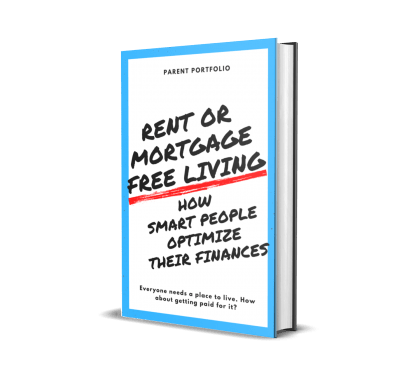The Secret to Financial Freedom: More Than Your Paycheck

No lottery. No inheritance. I did not sell a business for millions, either. I achieved financial freedom at 35 by using old-fashioned money principles that changed my life.
What is “financial freedom”, anyway?
Financial freedom means that you live a fully-funded lifestyle that does not require a full-time job to support, though you may still choose to work a job you enjoy.
It means you have complete control over your life and the choices that you make. The money component is no longer the primary factor in your decision-making process and you are not forced to do things (like work) because you need the paycheck to fund your standard of living.
That’s an incredible feeling.
Financial freedom is also commonly known as financial independence, and it too implies that you are no longer beholden to a job to fund your lifestyle.
Instead, your savings and investments are big enough to sustain your lifestyle for the foreseeable future without holding a job. You may choose to continue working jobs that you love, but the ability to quit work at a moment’s notice, without thinking about money, is what makes our lives truly “independent” and free.
How to Achieve Financial Freedom on Any Income
Financial freedom is an equation. And, it’s an equation that works almost every time. The equation doesn’t know about race or gender. It does not care about your upbringing or your past. The equation is about the numbers, and numbers are nearly as uncompromising as it gets.
Too often, people believe that income is the only part of the equation that matter. In other words, earn a big enough income and, well, obviously they can achieve financial freedom.
But, that’s just not true.
When nearly 25% of families that earn over $150,000 a year still live paycheck-to-paycheck, the numbers prove it’s not that easy.
According to CNBC, Americans hold over $800 billion in credit card debt, with the average person carrying almost $6,200 in debt.

It’s because earning an income is only a single part of what it takes to be free from money worries. To never have to stress about money. It’s not the only part, and to find out what it really takes to be free from financial stress, we need to take a look at the entire story.
This story begins with income, and how deceptive our paychecks can be.
The Deceptive High Income Problem
There is one major problem with earning a high income: we start to think that we can afford just about everything.
Big salaries give us a lot of resources to play with, and if we are not careful, we could quickly find ourselves spending the majority of what we earn.
And when we do that, nobody is getting ahead. Financial freedom is a distant prayer.
And, high-income debt is a common problem.
We like to tell ourselves that since we work long hours, we deserve to spend that money. We are, in essence, rewarding ourselves for all the hours and the stress to do our jobs. But, when those rewards start to become an integral part of our lifestyle, we systematically create a position of weakness.
Incomes are deceptive because when we don’t use them properly, we create a false sense of security. As the Coronavirus-inspired economic downturn of 2020 proved, things change.
And sometimes, quickly.
We may not always have good jobs. There is no way we can accurately predict the future. And, our spending habits today effect our lifestyles tomorrow – every time.
Our incomes are powerful forces, and when we use them in a smart and controlled way, we build a solid foundation for wealth.
It all begins with understanding the financial freedom equation.
The Financial Freedom Equation
This equation is simple: First, we earn an income. Nothing can truly happen without some sort of cash flow.
Second, if we do smart things with that income (like save and, more importantly, invest), our wealth grows over time. And finally, controlling our lifestyle helps to ensure that we have enough money, after paying for the basic necessities of life, to save and invest.
Step #1: Earn an income
To achieve financial freedom, your income does not need to be big. Though, the more money we earn, the more we can invest. But strictly, financial freedom is possible with virtually any income provided we are smart with every dollar that we earn.
For most of us, our jobs provide the majority of our incomes. Other times, side hustles and other creative tactics can bring in a bunch of additional income.
Step #2: Invest your income
Investing a good portion of our income is what sets us up to build wealth, and this wealth is what enables financial freedom.
Basic investment guidelines:
- Your checking account is not an investment; in fact, it’s one of the worst ways to “save” because your cash will not grow inside a checking account
- All real investments contain a risk; know this going into any investment
- Most investments are not “get rich quick”; instead, they tend to grow (and sometimes shrink) over time
- Be careful before getting into any “hidden jackpots” or investments that seem too good to be true hidden gems exist, but they typically are not easy to come by
Although there are plenty of strategies out there, I am a big believer in “slow and steady wins the race”, and that’s been my personal investment strategy for years.
Examples of common investments
Savings accounts, CDs (Certificates of Deposit), Treasury Bills and U.S. Savings Bonds are lower-risk investments, but they also offer a lower rate of return. Most high-wealth individuals do not solely rely on these types of investment accounts to build wealth, though they may include them in their overall portfolio..
Mutual Funds and ETFs are built for longterm investing and are a diversified set of stocks, bonds and securities in which investors collectively invest. These investment accounts provide a higher return potential, but they also include more risk.
Bonds are debts in the form of loans made to companies (or governments, cities) that pay a set interest rate over time. Bonds are typically less risky than stocks.
Stocks are shares of ownership in publicly traded companies. As investors buy stock, they also buy a stake in the company. Stocks are among the riskier investment options because if the company loses value, the value of its stock shares also decreases. But, if the company appreciates in value, each stock investor builds wealth.
Real estate investments include land, houses, apartment and office buildings and commercial complexes. Investors make money when the value of the land or the building increases in value.
401(k)s are pre-tax company-sponsored retirement plans belonging to employees. Many companies offer a percentage match of money contributed by the employee, making this an excellent option to invest. Note that there is no guaranteed return.
Roth IRAs are post-tax retirement accounts where money grows tax-free, making this another good option for investors to help grow their wealth. Note that there are contribution and withdrawal restrictions for both 401(k)s as well as Roth IRAs.
HSAs, or Health Savings Accounts, are hidden gems when it comes to investing, though they won’t be available to everyone. A health savings account is a pre-tax investment account used for qualified healthcare expenses. Contributions are generally not subject to federal income taxes and money grows tax-free. If you don’t use your HSA money for a medical expense by a certain age (in 2020, it was 65), withdrawals can be taken from the HSA without penalty.
Brokerage accounts are fully-managed accounts set up to allow individual investors to invest money in a variety of different stocks, bonds and mutual funds. These accounts are managed by the brokerage firm, but the money inside the brokerage account belongs to the investor.
Over time, investments tend to build wealth – though, no invest exists without a certain degree of risk.
Our investment playbook
My wife and I achieved financial freedom using 7 basic investment principles:
- Technique #1: We always invested at least the company-sponsored match (which was generally 4%) into our pre-tax 401(k)s.
- Technique #2: Toward the end of our full time working careers (the last two or three years), we maxed out both of our 401(k) and Roth IRA accounts.
- Technique #3: We built an emergency savings account with several years of living expenses.
- Technique #4: In addition to our 401(k) and Roth IRA investments at work, we invested post-tax income in a Vanguard brokerage account to further boost our investments.
- Technique #5: We automated everything that we could, including our contributions into our 401(k) accounts.
- Technique #6: We used a great online tool called Personal Capital to help keep track of our entire financial picture.
- Technique #7: We began using credit cards with the highest cash back and travel rewards points to take full advantage of the money that we were already spending.
Step #3: Control your lifestyle
The last step is controlling your lifestyle so your monthly expenses do not get out of control.
Streamlining your lifestyle is a three step process.
Those steps are:
- Know where your money is going,
- Identify ways to reduce spending, and
- Continuously monitor (ongoing)
The first step is the most important because without a good understanding of where our money is going, it’s very difficult to pinpoint where we can cut back.
It’s a tedious process, but go through your bank and credit card statements, line by line, to understand what you’re spending money on.
Avoid lifestyle inflation
A lot of us struggle with lifestyle inflation.
We start making more money and, in turn, we begin spending the majority of what we earn – simply because we have it to spend.
The causes of lifestyle inflation include:
- Earning progressively more money each year, with bonuses and raises, which provides us with extra cash to spend,
- We fund expensive vacations and huge purchases with all that “extra” money that we make year-to-year,
- Many work jobs that expect us to look successful, creating a wicked cycle of earn-and-spend (more on this below), and
- We try to keep up with our coworkers by matching (or exceeding) their level of spending on luxury items
As our incomes increase, so do our lifestyles.
In 2015, for example, CNBC reported that millionaires plan to spend $13,000 on vacations – in that year alone!
What’s the problem with that? If we spend the majority of the money that we bring in, we trap ourselves into a position where we NEED a high income, year after year, just to maintain the lifestyle that we built over the previous year.
High spending habits force so many big salaried households into a destructive debt-focused lifestyle that needs a high income to fund.
What happens to our lifestyle after that income stops?
Understand every expense
Make sure that you understand every expense (many descriptions are cryptic!).
Some online banking systems will help you categorize expenses to give you a better visual picture of your expenses. If they help, play with some of those tools to assist you in this process going forward.
This is a critical component in controlling your lifestyle. And, this is not the time to be judgmental. In step 2, we will learn how to decide what expenses to cut out.
Here are two important tips to help you as you dive through your statements.
Look for recurring expenses. These might include subscriptions to magazines, or memberships to clubs or websites, your cable TV package or anything else that gets billed on a regular basis. Highlight these expenses because we will use these in the next step of the process.
Categorize everything. Putting each and every expense into a category will help you to visualize at a higher level what areas of your life are costing you the most money. For example, common expense categories include restaurants, alcohol, groceries, travel, fuel, clothing, automotive repairs, home repairs and improvements, etc.
How to figure out what to cut
Next, we figure out ways to slash our expenses. To do this, I like to ask several questions:
Am I reading every magazine that I subscribe to? Enjoying the wine from that club I’m in? What about Netflix?
Or, are my vacations getting a little out of control? Could I cut back on where I go or what I do while on vacation?
Can I cook a little more at home rather than going out to eat so often?
Can I wash my own car rather than running it through the car wash? Or, cut my own hair instead of going to a barber? Make my own coffee at home?
Only you can answer these questions, but they will help us determine what expenses to lose during this process.
The bottom line with this step: Understand where your money is going, then cut out anything that isn’t critical to your life. Then, use this extra month to save and invest in appreciating assets. This is how money builds.
In Conclusion
Financial freedom is a simple equation, but it takes time to solve. Using smart money principles that utilize the true power of our income will enable more choices in our life because money is no longer the primary concern.
Money is a tool, and so is our income. Like a hammer, money can be used to build anything that we want.
We could use money to build a life full of consumption. We can buy the big house on the hill, or the pricey import luxury car, the expensive suits and nice dresses, dinners at high-priced restaurants, season tickets to sporting events, etc.
Alternatively, we could use that money to support the basic necessities of life and protect our futures, like living in a more reasonable home and driving a normal paid-off car, maintaining a 6-month emergency fund and investing the rest for our future retirement.
Or, something in-between.
Everybody’s money goal should be simple: use money strategically. Use enough money to maintain your family’s basic needs (and maybe a little more), then save and invest the remainder so you won’t need to spend the rest of your life working for the privilege of spending.
Saving and investing to achieve freedom from money is the smartest decision that anyone could ever make.






